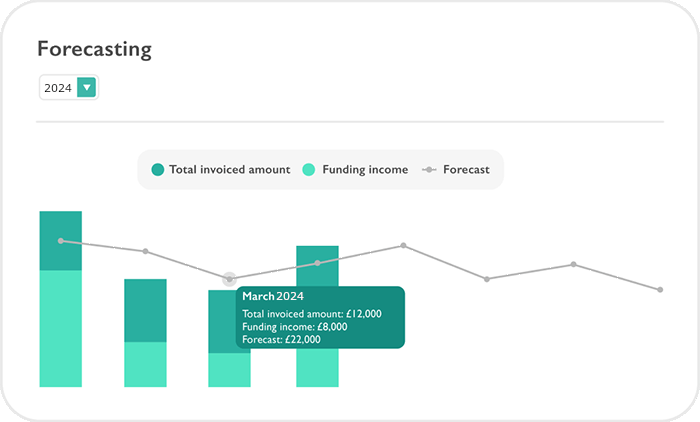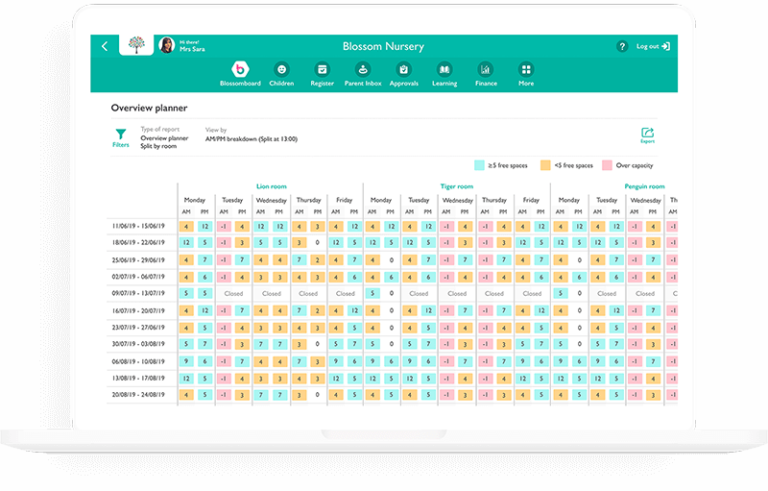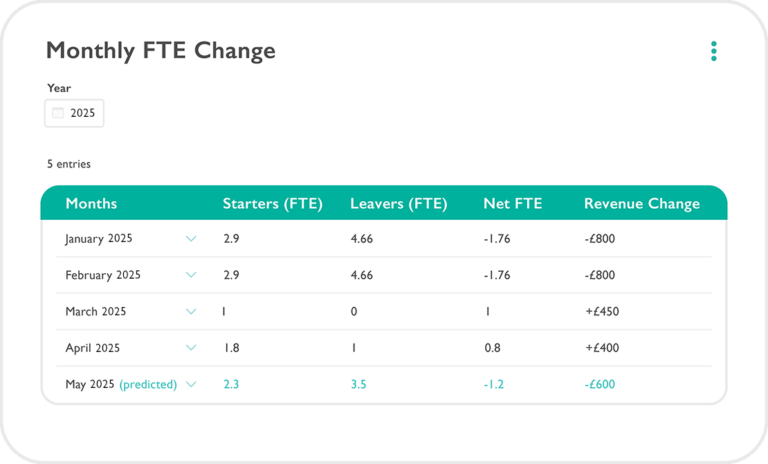Increasing your nursery’s profitability doesn’t mean hiking your prices up. It’s about being business-minded.
Making a profit as a childcare provider can be a taboo topic. Your childcare setting has one primary aim – to give the children the best educational start in life. You are also running a business, and profit (or breaking even at a minimum) is an absolute must.
Predictive analytics are non-negotiable for private companies. However, childcare can often be slightly behind the curve due to the overlap between public and private services offered.
In this article, we share how to use predictive analytics in your nursery to increase effectiveness and profitability.
What are predictive analytics?
Predictive analytics uses the data currently available to make predictions about future decisions.
In the childcare sector, predictive analysis helps to make informed guesses about budgets and capacity and drives strategic decisions.
Ultimately, business-minded people will naturally use predictive analytics to inform their next steps. Having guidance on what areas to use this data in and how to do it effectively will save your research time and improve effectiveness.
Why are predictive analytics important in childcare?
Let’s put it into an example – you want to improve the training and professional development available to your team.
There are a few options ahead of you:
- See what training takes your fancy after an afternoon of researching
- Notice training advertisements and think they’ll benefit your team, so sign up immediately
- Follow the CPD plan you created at the beginning of the year and find or create training to fit those needs
- Use emerging trends of child and family needs cross-sectioned between existing practitioner knowledge to find your training gaps
We all know which option is the most strategic and offers the most value, and handily highlighted it. But who has time to do number-crunching to find nursery-wide trends?
This is where you use predictive analytics to help make the decisions obvious.
Predictive analysis is not often used in early years and childcare. Still, it is a vital process nursery managers and owners should adopt to ensure the profitability of their settings.
Your setting may use predictive analytics (without realising it) in a few areas. We share the top areas you need to focus on to be data-savvy.
Nursery managers and owners: The data you need to know
Some data analysis falls into the ‘essential’ category, while others sit in the ‘nice to have’ category.
Here’s how to know which data categories are the most important.
Essential data for predictive analysis
- Nursery capacity figures (the spaces you have available to fill)
- Employee recruitment and retention averages
- Spending hotspots and trends
- Parent interest (Enquiries) vs. conversion to customer rate
- Family spending demographic (funded/non-funded places)
- Income vs outgoings (financial forecasting)
- Upcoming changes (Who’s leaving the nursery – children and staff)
- Return on investment (ROI) for hiring processes
'Nice to have data’ for predictive analysis
- Parents who are expecting another child
- Housing plans for the local area (increase in local population can impact nursery space demand significantly)
- Local and national funding and grant opportunities

How to use data to drive profitability in childcare
We share five key ways to use predictive analytics in childcare settings to boost income.
Those who are naturally business-minded will notice that predictive analytics goes hand in hand with effective practice and processes.
Analyse your nursery capacity
Nursery capacity is a term often misunderstood in the sector. What we mean by that is that it can be easy to think of the bigger picture of ‘bums on seats’ when you think capacity. Nursery capacity also covers the availability of day-to-day space.
For example, you have five children on holiday during the same week, which makes their nursery room quieter than usual.
Your setting has three straightforward options to choose from:
- Work the rotas to ensure the rooms stay within ratio and plan targeted CPD training for any staff that can be released.
- Plan additional interactive activities for the children to benefit from the quieter room.
- Advertise the capacity to parents to book extra sessions via your nursery management software.
If you do not have easy access to daily nursery capacity, you may be missing a trick for maximising profitability opportunities.

Questions to ask about your current provision:
- Can I see where the gaps are in capacity?
- Can I forecast where the gaps will be in the next 6+ months?
- Can ratios be calculated automatically to ensure we are always compliant?
Evaluate your retention rates
Predictive analytics rely on seeing the noise in the data. Having a long list of children who have attended your nursery is great, but what does that tell you? And how can you use that information to plan for the future?
Retention rates apply to both families and staff. Do you know the average length of time a child attends your nursery? Can you predict, if you have an intake of 12-month-olds (with the new government funding initiative), how long you will likely have them?
Similarly, do you know how long your early years practitioners stay with you before they move on? It’s important to see the noise behind the data to alter current practices (if patterns emerge) or prepare for staffing changes in advance.
Consider your ROI when advertising practitioner job positions
We all know Level 3 practitioners are like gold dust at the minute. With most nurseries struggling to recruit across a range of position levels. It may be time to consider how you attract (and retain) quality early years practitioners.
Common job search sites can be expensive to post adverts on and may not be a good return on investment (ROI). Predictive analytics highlights the most effective advertising avenue for generating interest in your nursery vacancies.
Here are some ideas for attracting nursery practitioners to your setting:
- Top job search sites (like Indeed)
- Local council job vacancy pages
- Your social media platforms
- Paid ads via your social media platforms
- Sharing into local social media groups (like Facebook groups for Early Education courses in your area)
- LinkedIn job adverts
Questions to ask about your current provision:
- Is there a predictive pattern for how long children and staff stay at my setting?
- What were the reasons for leaving for the last three practitioners?
- Which job vacancy option has the highest ROI for me?
- Are there any new avenues I need to try to recruit practitioners?
Parents interested vs. conversion to customer
When a parent books in for a walk-around at your nursery, it is important to act fast. As you know, they will be looking around other local nurseries at the same time. Good, fast communication can often sway their choice (as it predicts what they can expect as parents at your setting).
Predictive analytics surrounding parent conversions are essential for fine-tuning your parent interaction process. Not all nurseries follow up on walk-arounds, leaving a huge space of unknown information about why they chose a setting other than yours.

Questions to ask about your current provision:
- Do you know when your busiest walk-around season is?
- Have your parent-nursery visit busy periods changed with the funding changes?
- Does your setting follow up on parent feedback post-walk-around?
- Do you have a notification system in place to receive parent enquiries immediately?
Download our free ultimate guide to impressing parents on a walk-around (with expert advice from Kate Peach).
Funding predictions for childcare
Childcare funding has altered significantly in the last 12 months. Your setting will now be finding its feet with the increase in funded places and how to make the funding work for you.
When using data to analyse your nursery’s current financial position and plan for the future, you’ll need access to real-time business reports.
Nursery software tools to help you analyse your funding will help you to recognise patterns quicker and plan accordingly.

You’ll benefit from researching:

Predictive analytics for spending
When analysing your income vs outgoings, it is essential to have access to easy-to-read data about where your money comes in from and goes out to.
With a clear picture of spending, budgeting to meet your nursery goals becomes easier.
You can download our ultimate guide to nursery budgeting, which will talk you through each step, from cutting down spending to increasing income capacity.
Questions to ask about your current provision:
- Where are my opportunities for increased income generation?
- Are there hotspots for spending that can be reviewed?
- What are the initial predictions following the funding changes?
We often talk about how to find your niche and improve your nursery’s profitability. Stay informed with our monthly newsletter for trending blog round-ups, industry updates and EYFS activity ideas for your nursery.